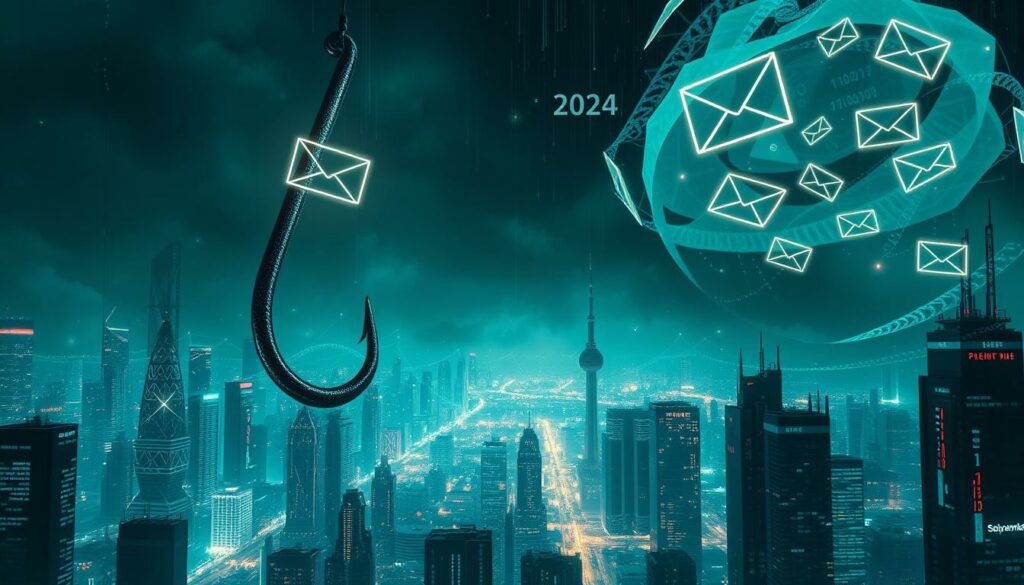Cybercrime is set to cost the world $10.5 trillion by 2025. As we move into 2024, knowing about cybersecurity threats is crucial. With more people relying on technology, IT security is more important than ever.
This year, we’re seeing new threats like AI-powered attacks and old ones like phishing scams. It’s important to have a strong plan to protect your data. Staying ahead of these threats is key to keeping your information safe.
Key Takeaways
- Cybercrime is expected to cost $10.5 trillion annually by 2025.
- IT security is crucial as dependence on technology increases.
- AI-powered attacks are rapidly evolving as a new threat.
- Phishing scams remain a persistent issue.
- Proactive cybersecurity strategies are essential for protection.
- Understanding cyber threats is key to mitigating risks.
Introduction to the Cybersecurity Landscape in 2024
The Cybersecurity Landscape 2024 is complex, shaped by fast digital changes in many sectors. Industries like healthcare, finance, and oil and gas are using more technology. This has led to more and more cyber threats. So, it’s crucial for companies to focus on preventing cyber threats to protect their digital assets.
In the oil and gas sector, the need for security services is growing fast. It was worth USD 26.53 billion in 2023 and could hit USD 43.74 billion by 2032. This shows how important advanced security and IT are in protecting important infrastructure from new threats.
Physical security is key in the oil and gas industry. There’s a big need for strong security and control systems. With managed services leading the market, companies can use the latest security tech without big upfront costs. This helps them quickly deal with threats.
Now, companies are working together more, making old manufacturing into digital networks. This makes things work better but also brings new cyber challenges. Old systems and a lack of skilled workers make it hard to use the security needed.
Geopolitical issues and supply chain problems also make things tough for industries. They test how strong companies are against cyber threats. To keep up with the Cybersecurity Landscape 2024, companies need to stay alert and improve their IT Security plans. This helps them stay ahead of threats.
Understanding Cybersecurity Threats
Cybersecurity is key for all kinds of organizations. It’s vital to know about Cyber Threats and Cyber Vulnerabilities to protect against risks. These threats come from hackers, malware, or insiders. Understanding them helps improve your Cybersecurity Awareness.
Defining Cyber Threats and Vulnerabilities
Cyber threats can affect both people and businesses. Here are some examples:
- Phishing attacks trick people into sharing private info.
- Malware, like viruses and ransomware, can harm systems or lock data away.
- DoS attacks flood systems to make them unusable.
Cyber Vulnerabilities are weaknesses in systems that hackers can use. Finding and fixing these is crucial for Data Security. It helps protect important information.
The Importance of Cybersecurity in Today’s World
Cybersecurity is very important today. As technology gets better, so do the ways hackers attack. Not having good cybersecurity can lead to big problems, like losing money, hurting your reputation, and losing customer trust.
Companies need to protect their data and systems to stay safe in the digital world. This means investing in strong cybersecurity tools, training employees, and making cybersecurity rules. These steps help make a company strong against cyber threats.
Emerging Cybersecurity Threats in 2024
Businesses face a tough tech landscape with Emerging Cyber Threats 2024 on the rise. Threats from AI and new ransomware tactics need strong defenses. Knowing these threats helps protect against big losses and improve cybersecurity strategies.
AI-Powered Cyber Attacks
AI Cyber Attacks are becoming more common. Criminals use machine learning to make their attacks smarter. They create phishing scams and exploits that traditional security can’t catch.
This leads to big IT Security Vulnerabilities for users and companies. With generative AI, attacks are getting more complex. Companies need to use AI security tools to stay ahead.
Supply Chain Vulnerabilities
Supply Chain Threats are getting worse as more devices connect to the internet. Sectors like energy are at high risk from attacks on third-party vendors. Companies must focus on Cyber Supply Chain Risk management.
This means checking partners for strong cybersecurity and following strict rules. Regular audits and compliance are key.
Ransomware Evolution and Trends
Ransomware is getting worse, with new tactics like double extortion. Attackers not only lock data but also threaten to share sensitive info. In 2024, having good backup plans and response strategies is crucial.
Most ransomware starts with phishing, so fighting phishing is very important. This helps tackle IT Security Challenges.
Cybersecurity Threats 2024: Statistics and Predictions
Cybersecurity is a top concern as threats and vulnerabilities grow. The latest reports show a worrying increase in cybersecurity incidents across different sectors. It’s vital for businesses to understand Cybersecurity Statistics 2024 to make strong security plans.
Recent Cyber Incident Reports
Recent data shows more breaches, especially in finance and healthcare. Key findings include:
- A 30% jump in cyber incidents from last year.
- Financial services saw the most breaches, with a big focus on stealing data.
- Healthcare faced more attacks, causing big disruptions in services.
These reports give crucial info for a deep Threat Analysis. They help organizations predict and get ready for possible weaknesses.
Predicted Trends in Cybersecurity Threats
Experts predict big changes in cybersecurity for 2024. This year, we’ll see more of these Emerging Threat Trends:
- More smart devices will lead to more vulnerabilities.
- AI-driven attacks will target both people and companies.
- There will be a focus on supply chain weaknesses, needing better security at all levels.
These predictions highlight the need for strong security measures and well-trained staff in organizations.
| Industry | Percentage Increase in Incidents 2023-2024 | Primary Target |
|---|---|---|
| Financial Services | 35% | Data Theft |
| Healthcare | 25% | PHI (Protected Health Information) |
| Retail | 20% | Payment Information |
| Manufacturing | 15% | Intellectual Property |
Insider Threats: An Ongoing Concern
Organizations face big challenges with insider threats. These are risks from inside the company. Employees might share sensitive info on purpose or by mistake. This includes leaks from unhappy workers or mistakes that let data get out.
To tackle these issues, you need a strong plan. This plan should include:
- Regular training for employees on spotting security risks.
- Keeping an eye on who sees sensitive info and systems.
- Doing security checks often to find weak spots.
It’s very important to stay alert against insider threats. As technology changes and teams grow, so do the ways bad insiders can act. Always check your security plan to stay ahead. Knowing how your team works helps you protect against insider threats better.
| Type of Insider Threat | Description | Prevention Strategy |
|---|---|---|
| Disgruntled Employee | Intentionally leaking sensitive data due to dissatisfaction. | Implement exit interviews and monitor behavior changes. |
| Accidental Insider | Unintentional data breaches caused by negligence. | Conduct regular training and enforce data handling protocols. |
| Compromised Account | External hackers gaining access through stolen credentials. | Utilize multi-factor authentication and regular password changes. |
| Social Engineering Victim | Employees manipulated into sharing confidential information. | Educate employees about common social engineering tactics. |
By knowing these risks, you can make your company more aware of security. This helps lower the chance of insider threats and makes your cybersecurity stronger.
Phishing Scams: The Persistent Cyber Threat
Phishing scams are a big worry in the world of IT security in 2024. More cybercriminals are using smart phishing techniques to trick people and get sensitive info. It’s key to know about these phishing scams to boost cyber threat awareness.
Identifying Phishing Trends
This year, BEC attacks have jumped, hitting companies with great accuracy. These scams look like real emails from bosses or trusted partners, trying to get employees to share secret info. Knowing the latest in phishing scams 2024 helps us get ready for threats.
Impact of Social Engineering Techniques
Social engineering threats play on human feelings, making them very effective. Hackers use emotional tricks to get people to share personal details. To fight these threats, teach your team about cybersecurity awareness. Doing regular phishing tests helps employees spot danger fast.
Being aware and educated is key to fighting phishing scams. Knowing about these threats helps protect your company. Staying updated on phishing scams and social engineering tricks boosts your security.

Impact of Increased Remote Work on Cybersecurity
Remote work has changed how businesses operate, bringing new challenges to Remote Work Security. More people working from home means more chances for cyber threats. This leads to a higher risk of Cybersecurity Risks 2024, as home networks often don’t have the same security as corporate ones.
Using personal devices for work adds more worries about Work from Home Security. Workers might share company data without meaning to, using unsecured devices. Companies need a strong cybersecurity plan to fix these issues.
Important steps include:
- Setting up secure remote access, like VPNs, for safe connections.
- Creating rules for using personal devices safely at work.
- Teaching employees how to spot and deal with cyber threats, especially phishing attacks on remote workers.
- Keeping all work-related software updated and patched.
As companies adjust, focusing on Remote Work Security is key. It helps protect sensitive info and keeps operations running smoothly.
Securing IoT Devices Against Intrusion
The rise of IoT devices brings great convenience but also big cybersecurity challenges. As more devices join our daily lives, they bring new risks. It’s key for businesses to know about IoT vulnerabilities in 2024 to stay safe.
They need to fix issues like poor authentication and slow software updates. This helps protect your systems from threats.
Challenges Posed by IoT Vulnerabilities
IoT devices often have basic security problems, such as:
- Weak authentication measures that allow unauthorized access
- Insufficient software updates that leave devices vulnerable
- Inconsistent security protocols, making compliance difficult
These IoT vulnerabilities 2024 are a big threat. Companies must act fast to keep their networks safe.
Best Practices for IoT Security
To boost IoT cybersecurity, follow these best practices:
- Update device software often to fix bugs and boost security.
- Use strong authentication, like multi-factor, to control access.
- Put IoT devices on separate networks to reduce risk.
- Invest in Intrusion Detection Systems (IDS) for quick threat detection.
- Do detailed checks on all IoT devices to meet security standards.
By following these IoT Security Best Practices, you can lower risks and improve your cybersecurity.

The Role of Government Regulations in Enhancing Security
Government policies are key in shaping cybersecurity. Following cybersecurity rules helps protect organizations and promotes a culture of responsibility. It also improves how businesses manage risks.
Current Regulations Impacting IT Security
Many important rules guide how companies handle cybersecurity. These rules help institutions stay on track and manage risks well.
- General Data Protection Regulation (GDPR): This major rule stresses the need for protecting data and privacy in Europe. It forces companies to be strict with user data, affecting IT security worldwide.
- Health Insurance Portability and Accountability Act (HIPAA): HIPAA is for healthcare groups. It demands strict steps to keep patient info safe, showing how crucial cybersecurity is for health data.
- Cybersecurity Maturity Model Certification (CMMC): For defense contractors, CMMC needs companies to follow certain cybersecurity steps. It ensures they meet defense policy standards.
It’s crucial to know these rules. They shape how businesses deal with data and keep it safe. They also affect cybersecurity policies at all levels.
| Regulation Name | Primary Focus | Key Compliance Requirement |
|---|---|---|
| GDPR | Data Protection and Privacy | Data breach notifications within 72 hours |
| HIPAA | Healthcare Data Security | Regular risk assessments and audits |
| CMMC | Defense Contractor Cybersecurity | Certification through a third-party assessment |
Following these rules helps you meet legal standards and boost your cybersecurity. The rules change often, so staying updated is key. Regular training on these rules helps protect against cyber threats.
Strategies to Combat Cybersecurity Threats in 2024
Cyber threats are getting more complex. Organizations need strong strategies to protect their data and systems. This includes investing in new tech, training employees, and doing regular checks.
Investment in Cybersecurity Technologies
Putting money into cybersecurity is a must in today’s digital world. Look into the latest Technology Solutions 2024 to boost your security. Tools that use threat intelligence and AI are key for staying ahead of cyber threats.
These technologies give deep insights into vulnerabilities and can respond to threats automatically. They are vital for IT Security Strategies.
Employee Training and Awareness Programs
Your team is a key defense against cyber attacks. Regular Cybersecurity Training and promoting Employee Awareness equip employees to spot and handle threats. It’s important to have training for different jobs in the company.
This ensures everyone knows why following IT Security Best Practices is important.
Regular Security Audits and Assessments
Doing Security Audits often and detailed Cybersecurity Assessments shows where you’re weak. This helps improve security and make smart choices based on data. Being proactive means you’re ready for threats, not just reacting to them.
Conclusion
The digital world is getting more complex and risky. Threats like AI-powered attacks and new ransomware types mean companies must act fast. With cybercrime costs expected to hit USD 10.5 trillion by 2025, it’s time for businesses to protect their assets.
IT Security Insights show a huge number of threats, with many IT pros facing thousands to millions of cyber threats daily. Challenges like insider threats and vulnerabilities in IoMT add to the security issues. To stay ahead, companies need strong Cybersecurity Strategies. This includes regular security checks, training for employees, and using the latest security tech.
Keeping data safe and your organization strong depends on good cybersecurity steps. As cyber threats change and corporate boards focus more on security, it’s key to make security a top priority. Your company must stay alert to handle this complex situation well.
FAQ
What are the main cybersecurity threats businesses should prepare for in 2024?
In 2024, businesses should watch out for AI-powered cyber attacks, supply chain weaknesses, and evolving ransomware. These threats are getting more complex. It’s key for companies to boost their IT security.
How does the rise of remote work impact cybersecurity?
Remote work brings new risks, like unsecured home networks and personal devices. Companies need to improve their cybersecurity for remote work. They should focus on secure remote access and endpoint security.
What types of phishing scams are prevalent in 2024?
Phishing scams now include business email compromise (BEC) attacks aimed at companies. Criminals use smarter tactics. It’s vital to educate users to fight these scams.
What role do government regulations play in cybersecurity?
Laws like the General Data Protection Regulation (GDPR) are key in setting cybersecurity standards. Following these laws boosts security and builds trust with customers.
How can organizations mitigate the risks associated with IoT devices?
To secure IoT devices, update software regularly, use strong authentication, and monitor devices for threats. This prevents unauthorized access and attacks.
What is the importance of employee training in cybersecurity?
Training employees is crucial for a security-aware team. It helps them spot and handle threats. People are often the weakest link in security, so teaching them is key.
What steps should organizations take to prepare for potential insider threats?
Companies should have strong internal security, do regular checks, and watch for suspicious actions. This helps catch insider threats, whether by mistake or on purpose.
How can companies effectively respond to ransomware attacks?
Companies should back up data and have a plan for ransomware attacks. Using advanced security helps protect data and keeps business running after an attack.
What statistical trends are emerging in cybersecurity incidents for 2024?
More breaches are happening in areas like finance and healthcare. Experts predict more cyber incidents. This means companies need to update their security plans.
Why is it crucial to understand cybersecurity vulnerabilities?
Knowing about cybersecurity weaknesses is key because hackers can use them for attacks. This leads to data breaches and losses. Being aware helps companies protect themselves better.
Source Links
- Should You Buy SentinelOne Stock Instead of CrowdStrike? | The Motley Fool
- Oil and Gas Security and Service Market to Reach USD 43.74 Billion by 2032 Due to Rising Cybersecurity Threats and Physical Security Concerns | Research by SNS Insider
- The Rapid Transformation of the Machinery Industry: Automation, Alliances, and Accelerated Growth
- Virtual Private Network Market: The Impact of Technological Advancements and Cybersecurity Threats Market Trends and Growth Forecast Report 2024 – 2031
- Next-Generation Attacks, Same Targets – How to Protect Your Users’ Identities
- Top 16 Cybersecurity Threats in 2024 | Embroker
- Cybersecurity Threats Affecting Businesses in August 2024
- SIG expands forest conservation efforts in Malaysia
- TRAI proposes overhaul of spam regulation mechanisms
- The United States needs a long-term approach to Ukraine aid
- New ManticoraLoader Malware Attacking Citrix Users To Steal Data
- Understanding University Students’ Foreign Language Learning Attitudes: An Analysis Based on Stereotypes
- Validity and Reliability of Movesense HR+ ECG Measurements for High-Intensity Running and Cycling
- Optimized Intrusion Detection for IoMT Networks with Tree-Based Machine Learning and Filter-Based Feature Selection
- Early-Stage Prototype Assessment of Cost-Effective Non-Intrusive Wearable Device for Instant Home Fetal Movement and Distress Detection: A Pilot Study
- SEBI Bans Liaison with Finfluencers for Registered Entities
- Lufthansa CEO meets Portuguese ministers over taking stake in TAP, sources say
- The Internet of Things Technological Perspective
- A Practical Guide to Risk-Based Cybersecurity Reporting.pdf
- PEAKLIGHT Dropper: Hackers Target Windows With Downloads
- My Guide to Understanding Data Centre Architecture: Core Components Every IT Pro Should Know
- Wazuh Home Network Setup: A Step-by-Step Guide
- Quantum Computers Decrypting Blockchain: The Risks and Implications
- Wazuh: Enterprise-Grade Security for Your Business
- Wazuh for Beginners: A Comprehensive Guide




